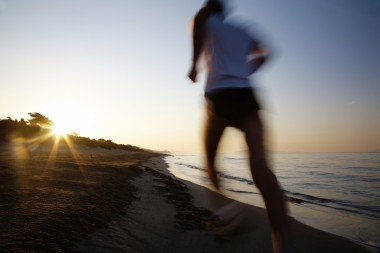
The knee is a complex joint comprised of many components, highly vulnerable and easily injured. The large ligaments of the knee provide stability while the meniscus, which is a soft wedge of cartilage between the thighbone and shinbone, cushions the knee and absorbs shock from the movements of the knee.
RUNNER’S KNEE – WHAT IS IT & WHAT CAUSES IT?
Runner’s knee – or patellofemoral pain – is a condition caused by continual heavy stress on the knees, which is common in physically demanding activities such as running, jumping, skiing, cycling and playing soccer. It causes a dull, aching pain either under or around the front of the knee. The pain can be felt walking up or down stairs, kneeling, squatting or sitting for a long time with knees bent.
Runner’s knee refers to a number of conditions which may cause pain under or around the front of the knee. These include:
- Anterior knee pain syndrome: a result of irritation to the soft tissues, most often strained tendons, causing chronic pain in the front and center of the knee.
- Patellofemoral malalignment: when the kneecap is out of alignment, symptoms often intensified by intensive training or activities causing excessive stress on the cartilage of the kneecap.
- Chondromalacia patella: a condition which causes the softening and breakdown of the cartilage on the patella. Symptoms are irritation of the joint lining and pain in the underlying bone.
The knee has a complex and sensitive structure, and there are a number of contributing factors which may cause patellofemoral pain: malalignment of the kneecap, a partial or complete dislocation of the knee cap, a knee injury, excessive training and overuse putting stress on the knee, and inadequate stretching before and after running or participation in sports activities. Thigh muscle weakness, soft tissue tightness or muscle imbalance, and flat feet can also cause pain in the knees.
TREATMENT
If you suffer from knee pain following sports activities, it’s important to stop doing any physical activities that hurt the knee, and don’t start up again until you can do so without feeling pain.
For first aid treatment for the pain and swelling, remember:
R.I.C.E. — Rest, Ice, Compression, Elevation
- Rest and avoid putting pressure on the painful knee. Swimming is a safe, non-weight-bearing activity for this period of healing.
- Ice. Use cold packs or ice wrapped in a towel several times a day for short periods of time on the injured area to help relieve pain and swelling.
- Compression can be achieved using an elastic bandage or knee sleeve with a hole cut out for the kneecap. It should fit snugly without causing additional pain.
- Elevate the injured area by placing the knee on a pillow so it’s raised up higher than the level of the heart.
Additional methods of pain relief include taking nonsteroidal anti-inflammatory medications such as aspirin or ibuprofen. After rest and pain medication, if you don’t feel any improvement in your knee, you should consult your doctor. As with all sport injuries, it’s important to consult a doctor for early diagnosis and treatment recommendations. The good news is that runner’s knee usually heals with early diagnosis and treatment including reconditioning.
Individual treatment recommendations depend on the reasons for the knee pain. You may require reconditioning to recover your full range of motion, strength, endurance power, speed, dexterity and coordination. Rehabilitation typically includes an exercise program to regain the flexibility and strength of your thigh muscles, and exercises for stretching.
There are various other treatments including taping the kneecap or using a knee support brace or shoe insert – these may also help relieve knee pain and help in gradually returning to running or other sporting activities.
Find OSS on Facebook and follow on Twitter to keep up to date on new articles and news.
